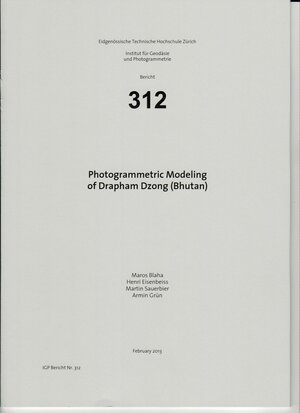
×
![Buchcover ISBN 9783906467931]()
Photogrammetric Modeling of Drapham Dzong (Buthan)
von Maros Blaha, Henri Eisenbeiss, Martin Sauerbier und Armin GrünThe following report is based on the bachelor’s thesis of Maroš Bláha which was accomplished in spring 2010 at the Institute of Geodesy and Photogrammetry (ETH Zurich).
The main topic of the Bhutan project is the photogrammetric modeling of the ruin of Drapham Dzong. The required input data was captured during the field campaign from 2 – 13 November 2009 during which the ancient citadel was documented using the UAV (Unmanned Aerial Ve-hicle) system MD4-200 in addition to terrestrial images. This documentation was carried out within the framework of the first archeological project in the Kingdom of Bhutan. The goal is to generate a DSM (Digital Surface Model) of the ruin and its environment as well as an or-thoimage of the corresponding area. These products can then be used for further projects mainly in the field of archeology. In addition, the aim was to visualize the castle complex and show the results at the Bhutan exhibition at the Rietberg Museum in Zurich (4 July – 17 October 2010).
The first part of this report contains some basic theoretical principles which were applied during the data processing. Subsequently the photogrammetric evaluation of the image data is ex-plained in detail. Thereby a distinction is made between UAV image processing and terrestrial image processing. The final results of these procedures are the orthoimages and an overview map of the main ruin structures in addition to a digital 3D model of further ruin objects adjacent to the main citadel. In the conclusion some further works relating to the photorealistic 3D model and the visualization products of the ruin are introduced.
The main topic of the Bhutan project is the photogrammetric modeling of the ruin of Drapham Dzong. The required input data was captured during the field campaign from 2 – 13 November 2009 during which the ancient citadel was documented using the UAV (Unmanned Aerial Ve-hicle) system MD4-200 in addition to terrestrial images. This documentation was carried out within the framework of the first archeological project in the Kingdom of Bhutan. The goal is to generate a DSM (Digital Surface Model) of the ruin and its environment as well as an or-thoimage of the corresponding area. These products can then be used for further projects mainly in the field of archeology. In addition, the aim was to visualize the castle complex and show the results at the Bhutan exhibition at the Rietberg Museum in Zurich (4 July – 17 October 2010).
The first part of this report contains some basic theoretical principles which were applied during the data processing. Subsequently the photogrammetric evaluation of the image data is ex-plained in detail. Thereby a distinction is made between UAV image processing and terrestrial image processing. The final results of these procedures are the orthoimages and an overview map of the main ruin structures in addition to a digital 3D model of further ruin objects adjacent to the main citadel. In the conclusion some further works relating to the photorealistic 3D model and the visualization products of the ruin are introduced.


